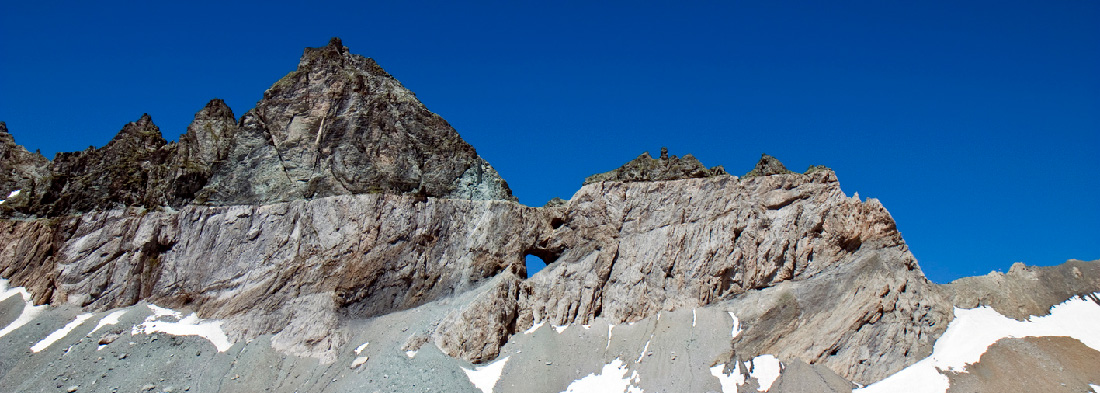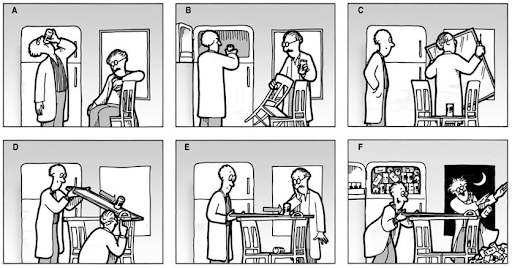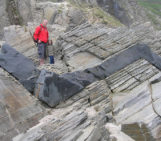
“The Role of Fluid Pressure in Mechanics of Overthrust Faulting” by Hubbert and Rubey is a “groundbreaking” article from the end of the 1950s. It’s a remarkable piece of research, written in an old-fashioned way, for modern standards. Many ECS that may not have read the original paper yet are certainly familiar with its textbook content. Let’s go quickly through it!
The article, as a key point, originally explains how fluid pressure aids low-angle tectonic transport of massive sheets of rock. Given that the magnitude of the force needed to translate rock sheets would exceed the compressive strength of most rocks in the crust, large thrust sheets should not exist. But they do, and the authors show that high elevated fluid pressures in rock pores at kilometric depths are close to the pressure of the overlying cover (i.e. lithostatic stress). Fluid can thus initiate motion by introducing a strength contrast and thus reducing the overall strength along the fault plane.
The paper starts with an historical overview of the problem of overthrust faulting and how it evolved. This shows that researchers were well aware 70 years ago that thrusting over near-horizontal fault planes was complicated from a mechanical point of view. The article describes the most famous thrust sheets that were known and follows to introduce the mechanical concepts needed to explore the authors’ solution to the ‘paradox of overthrust faulting’. Hubbert and Rubey outline the question “how is it mechanically possible to do something like this?” after being inspired by the beautiful Glarus Thrust in the Swiss Alps (https://whc.unesco.org/en/list/1179).

Glarus thrust fault at the Tschingelhoren (© https://geoscience-meeting.ch/sgm2017/)
The authors make a funny analogy of the process with an ice cold and room temperature beer can, moving on an inclined plane (see cartoon): an image definitely stuck in the mind of TS students worldwide.

Hubbert’s and Rubey’s experiment steps: (A) drink a beer; (B) put the empty can in the freezer to obtain a thin cover of ice on the can; (C) build “an apparatus” (a table top) while drinking a second beer; (D) observe that you need a high angle to make the room temperature beer slide on the table; (E) observe that you need a much lower angle to make the ice cold beer slide on the table; (F) Repeat the experiment, but be careful not to drink too much beer! Artwork by D. A. Fischer, in Davis, Reynolds, Kluth (2011) Structural geology book.
Fluid overpressure is still considered one of the prime mechanisms to explain fault weakness. However, we know now that there are other fault weakening mechanisms. Bulk mineralogy characteristics (e.g. abundance of phyllosilicates or presence of serpentine) and the efficiency of structure localization (e.g. change in grain size or influence of melt) during deformation are other prime candidates (e.g Collettini et al., 2019). Think about megathrusts today! Extremely weak and a topic so much debated in the TS community nowadays (e.g. Gao and Wang, 2014).
Armin Dielforder, David Fernández-Blanco and Christoph von Hagke participated in the discussion by the time this post was written. We like to highlight Christopth’s comment that Hubberts and Rubey’s contribution received several critical comments from other researchers. Now we know it is a classic, and that we should not get discouraged if criticized.
“The Role of Fluid Pressure in Mechanics of Overthrust Faulting” is a “TS must-read” if you want to familiarize yourself with the Coulomb wedge theory. It paved the road for articles that we will comment during the next months: Davis et al. (1983) Mechanics of fold‐and‐thrust belts and accretionary wedges (on February-March 2021), and Dahlen (1990) Critical taper model of fold-and-thrust belts and accretionary wedges (on May-June 2021).
Written by Gianluca Frasca, Armin Dielforder, and David Fernández-Blanco, and the TS Must-Read Team
References
Collettini, C., Tesei, T., Scuderi, M.M., Carpenter, B.M., Viti, C., 2019, Beyond Byerlee friction, weak faults and implications for slip behavior, EPSL, https://doi.org/10.1016/j.epsl.2019.05.011
Davis, G.H., Reynolds, S.J., Kluth, C.F., 2011, Structural geology of rocks and regions, John Wiley & Sons
Dahlen, F. A., 1990. Critical Taper Model of Fold-And-Thrust Belts and Accretionary Wedges. Annual Review of Earth and Planetary Sciences, v 18 (1), 55-99.
Gao, X., and Wang, K., 2014, Strength of stick-slip and creeping subduction megathrusts from heat flow observations, Science, https://doi.org/10.1126/science.1255487




